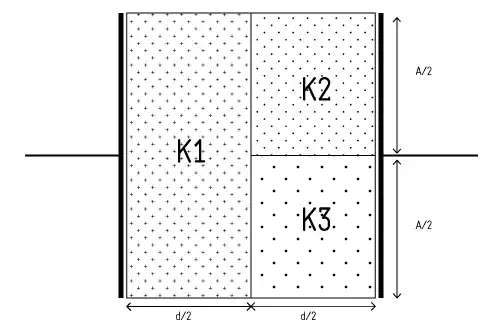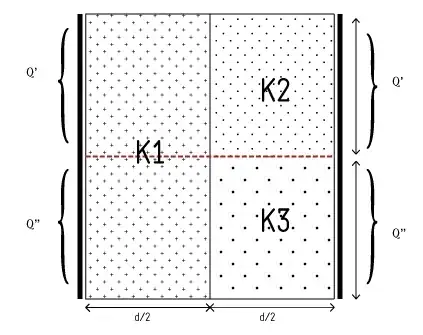I had this Homework Problem with a capacitor (parallel plate) that has a group of 3 dielectrics between it like so :

Now We were asked to find the equivalent capacitance and the distance of separation between the plates was $d$ and its area was $A$.
Now i assumed that the 3 individual dielectrics would act as individual capacitors and K2 would be parallel to K3 and their resultant series with K1
This was also the method I found in many other books.
$$C_{k1}~=~ \frac{2K_1\epsilon_oA}{d} $$ $$C_{k2}~=~ \frac{K_2\epsilon_oA}{d}$$ $$C_{k3}~=~ \frac{K_3\epsilon_oA}{d}$$
Finally $$C_{2,3}= \frac{K_2\epsilon_oA}{d} + \frac{K_3\epsilon_oA}{d} \implies \frac{(K_2+K_3)\epsilon_oA}{d}$$
And $$C_{(2,3),1} = \frac{\frac{(K_2+K_3)\epsilon_oA}{d}.\frac{2K_1\epsilon_oA}{d}}{\frac{(K_2+K_3)\epsilon_oA}{d}+\frac{2K_1\epsilon_oA}{d}}$$
Our teach told us that the answer was incorrect , When I told him about the books he told us that the books had it all wrong. So I asked him for the solution .
He divided the First Dielectric Into two parts along the line joining the bisector of area :

And Did the shown Charge distribution.
Later he equated the potentials and stuff like so
$$V_{Q'_1,Q'_2}=\frac{Q'd}{K_1\epsilon_oA}+\frac{Q'd}{K_2\epsilon_oA}~~~~....1$$ $$V_{Q''_1,Q''_3}=\frac{Q''d}{K_1\epsilon_oA}+\frac{Q''d}{K_3\epsilon_oA}~~~~....2$$
then said that $V_{Q'_1,Q'_2}=V_{Q''_1,Q''_3}$ he then put the values of $Q',Q''$ in the equation $$C=\frac{Q'+Q''}{V}$$
Basically getting a result that was quite different from the result given in books .
- I asked him how a single plate , the one in contact with the K1 dielectric could have Two different charges on the same surface.
- He told me that it was because of the accompanying dielectrics
- Was my question valid the first point ?
- Whose solution is correct?